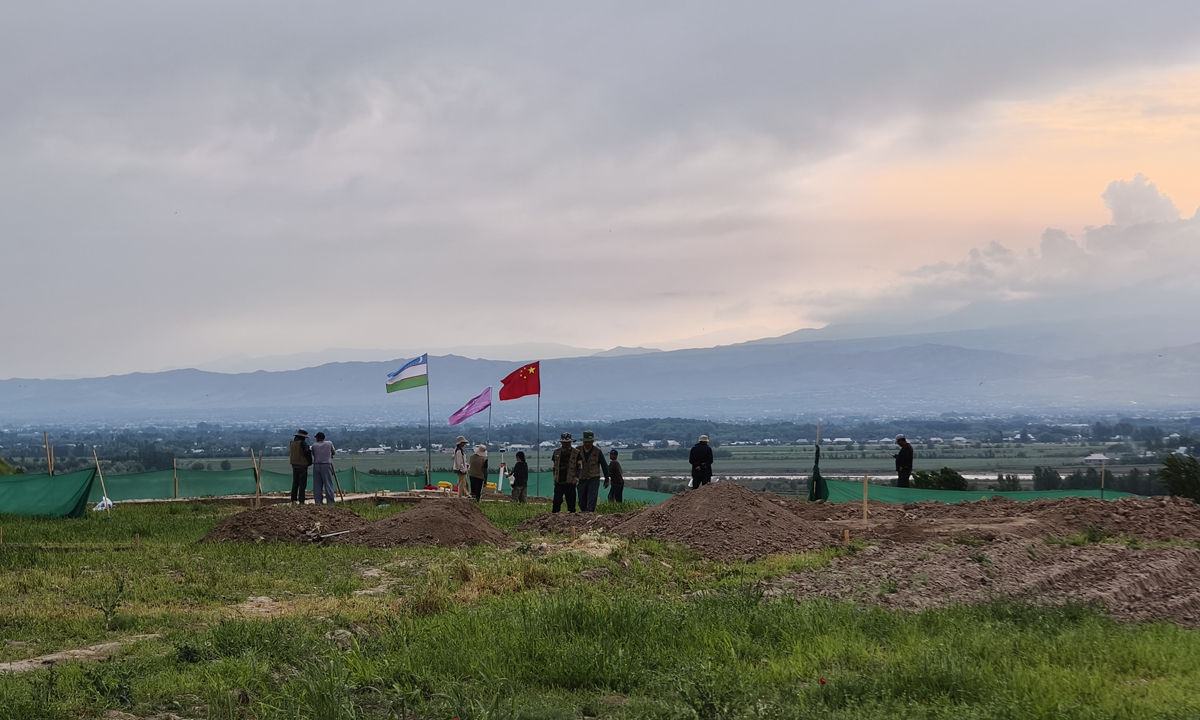
A joint archaeological site in Uzbekistan Photo: Courtesy of Tang Yunpeng
A joint archaeological team formed by China and Uzbekistan has discovered a large number of cultural relics,
mk including silk fragments, coins and a bronze mirror from the Han Dynasty (206BC-AD220), at the renowned Mengchaktepa site in Uzbekistan. These artifacts confirm the site's pivotal role as a hub along the ancient Silk Road, a trade route once connecting China with Central Asia and the rest of the world.
A total of six tombs and two buildings were unearthed at the site, a Chinese expert said, noting that the large number of discovered cultural relics are expected to help archaeologists uncover the history of the Silk Road during the Wei (220-265), Jin (265-420) and Northern and Southern Dynasties (386-589).
This also marks the first time after almost four decades that silk was unearthed at the Mengchaktepa site as well as in Fergana Valley, where the site is located.
Since 2012, the China-Uzbekistan joint archaeological team has been conducting archaeological excavations in Uzbekistan, especially in the ruins of the ancient city of Mengchaktepa, where a large number of cultural relics from the Han Dynasty were discovered, indicating the frequent circulation of goods in this region.
The part of the Mengchaktepa site excavated this time is located in the northwest corner of the basin. According to archaeological research conducted in 1986, this part of the site existed at the same time as that of the Wei, Jin, Northern and Southern Dynasties in China.
Liu Tao, an archaeologist from the Chinese Academy of Social Sciences and the Chinese executive leader of the China-Uzbekistan joint archaeological team, told the Global Times that the unearthed silk pieces were found near the tibia of the skeleton of the tomb owner and appeared to have been part of the leg of a pair of trousers.
The last excavation before the current one was conducted in the 1980s. Silk was also found at that time. Research showed that the silk had been produced in China, Liu noted.
He noted that in-depth study of the silk discovered this time is still needed before any decisions about the pieces' origins can be made.
The archaeological team also found several copper coins scattered around the tomb. One coin was so badly rusted that it was impossible to tell whether it had any writing on it. However, researchers can still tell that it was an ancient Chinese circular coin with a square hole.
Liu told the Global Times that no matter where the coin was minted, it is clear that the design of the coin was directly influenced by Chinese civilization. "By the time of the Wei, Jin and Northern and Southern Dynasties, it can be seen that the region was not just influenced by the circulation and spread of goods, but also directly influenced by our Chinese culture," said Liu.
The unearthed silk and coins at the Mengchaktepa site have been sent to a laboratory for detailed research. More conclusions are expected to be reached in 2025, according to a report by CCTV News.
The joint archaeological project started in September with more than 10 experts from China. Thanks to the extra expertise, the originally inconspicuous tombs at the Mengchaktepa site are expected to provide more information about the history of the region.
The six tombs discovered at the site are different from the commonly used coffins in ancient China. The joint archaeological team discovered that reed coffins had been woven from reed stalks that had been tied into bundles and then braided, and wrapped with wood to become the main structures. Experts introduced that the Mengchaktepa site was right next to the Syr Darya River, where the reed plants grew, so making reed coffins may have stemmed from the use of local materials.
However, the structure of the tombs was similar to those in Central China. The six tombs have tomb passages, adobe sealed doors and cave chambers. One large tomb is 3 meters wide from east to west, nearly 4 meters long from north to south, and nearly 2 meters high. Its top is slightly arched, with two steps between the tomb passage and the cave chamber, an adobe gate is at the top of the tomb.
Tombs with cave chambers began in the middle of the Warring States Period (475BC-221BC), and became popular during the Han Dynasty.
Liu said that to carry out physical anthropology research and ancient DNA research on these unearthed human bones, the team has applied all the technicalogical methods used in Chinese archaeology to analyze newly unearthed materials.

